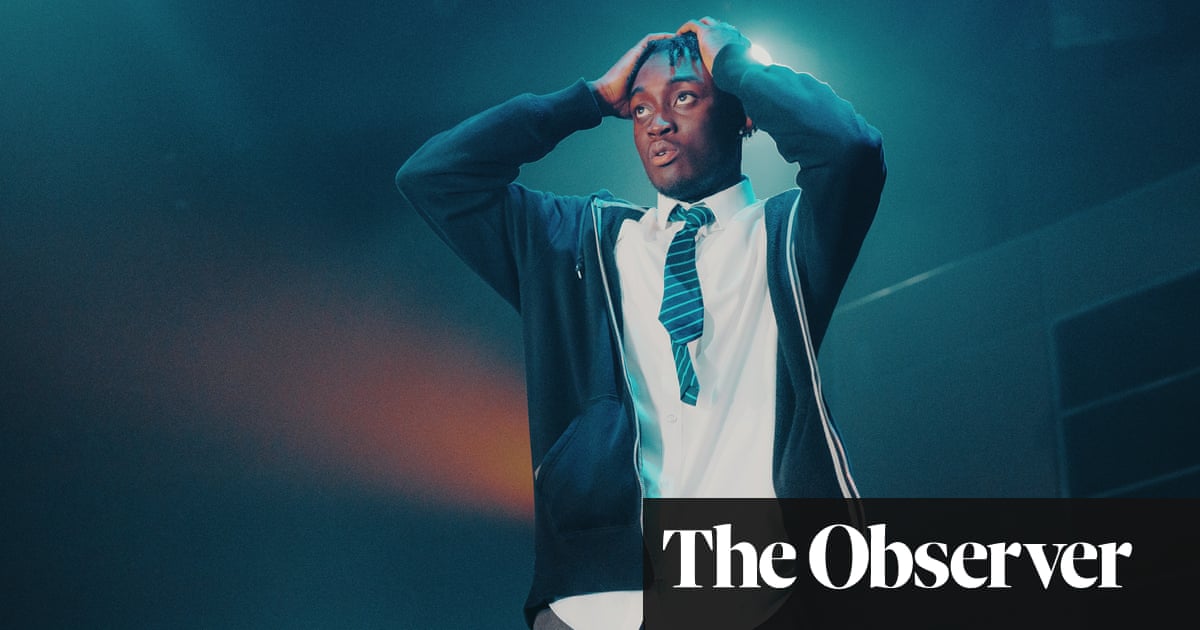What is the real thing? The question is an ideal subject for the stage, where the actual and the illusory constantly shadowbox. It was tackled in three strikingly different productions last week.
G, directed with fluorescent dynamism by Monique Touko, is an encouraging sign that David Byrne’s Royal Court will live up to the theatre’s bold tradition: he took over from Vicky Featherstone this year. Tife Kusoro’s fascinating new play thrills and tantalises from the opening moments. From a gulf in the middle of the stage (traverse, with the audience pressing close on both sides), an arm in white padded jacket like a Michelin man reaches up and out amid a swirl of smoke. Neon headlines zoom over the floor, announcing a mysterious crime. Above, dangling from a hook, are a pair of white trainers: they glow as might a statue of the Madonna when touched by a divine light. They belong to Baitface, a teenager killed while being chased by police for a crime he didn’t commit, who is said to steal the identity of black schoolchildren.
Not since Jasmine Lee-Jones’s Seven Methods of Killing Kylie Jenner in 2019 have I felt such a mixture of excitement and bewilderment. Action and speech is rapid, though there is a small sag in the middle, and there were several moments when I could have done with more signposts. Yet I was swept through miasmas of doubt by the talented conviction of actors – Selorm Adonu, Kadiesha Belgrave and Ebenezer Gyau – and by the knowledge that confusion, a dissolving of realism, is central to a play that features spells and curses and uncertainty about the interpretation of patchy evidence (contaminated by police prejudice). Nightmares and weed-induced befuddlements mingle with CCTV footage. Madeleine Boyd’s design melts under Adam King’s lighting and Tyler Forward’s video.
As Baitface, Dani Harris-Walters, his features blanked out by a white “bally” (balaclava), patrols the action in slow motion as if he were floating. He looms above the stage; he climbs under it; he steps down to the audience to transfix a spectator with his incorporeal eyes – haunting as the play itself.
I had thought that John le Carré’s fiction would forever be a closed book to me. All that Male Intelligence being too like male intelligence. Until I read The Spy Who Came in from the Cold and realised that cold war espionage not only made an extraordinary political chiller – with evident current reverberations – but was also a drastic map of human pretence, subterfuge, evasion, confrontation. The title has two meanings: the non-hero, Alec Leamas, is not only leaving the frozen world of spies; he is also getting his heart shaken.
No better playwright to chart the surprise of this than David Eldridge – creator of Beginning and Middle. His writing exceptionally combines naturalism (which includes lying and silence) and particular delicacy. In adapting le Carré, Eldridge draws on these talents, emphasising the seam of reluctant romance and giving chances to shine to appealing Agnes O’Casey and terrific Rory Keenan, who makes Leamas something like Columbo: slovenly in appearance (that knot in his tie is slipshod) but seething in his brain. He is still, unreadable; he looks as if he is drifting but is actually driving. Until he falls.
Jeremy Herrin’s production has fine noir sequences. Not least when John Ramm as Smiley appears, overseeing the action (and looking unnervingly like Alec Guinness). He opens the evening with a most beautiful quiet moment, unlike anything I have seen before: blowing on the lenses of his specs to clean them. In a smart piece of double-casting in this drama of double agents, he also appears as a German lawyer – and former Nazi.
What is lacking is drive. Rightly seeking to preserve the novel’s enigma, Eldridge offers gaps, twists and flashbacks that are more puzzling than intriguing. It would not be difficult to straighten this out and make an evening of fragmentary distinction into a compelling event.
The Real Thing – first staged in 1982 – is the most evidently loving of Tom Stoppard’s plays and one of his most accomplished. A word-spinning, form-crunching demonstration of the way the real and the pretend spin around each other in the theatre. This is apparent (not fair to say how) from the off. And if that sounds too Stoppardianly clever, well, there is a Stoppardianly clever parody of the Stoppardianly clever.
A romance between a playwright and an actor gives rise to penetrating speeches on love and on writing. The limits of eloquence are made evident, but the case is strongly made for eloquence not necessarily being suspect and inarticulacy not always signalling authenticity. Bel Powley grows persuasively from Bambi (how rapt I was by her first appearance as a 17-year-old in 2009) to doe; James McArdle is compelling in oration and in his unravelling. A lovely musical thread pits classical against pop, Bach against Procol Harum. There is more than one beat of autobiography here: Stoppard listened to Subterranean Homesick Blues while writing Rosencrantz and Guildenstern Are Dead.
There are blotches in the play and in Max Webster’s production. The figure of a Glaswegian ex-prisoner is a reach-me-down joke. What begins as a lover’s sweet protectiveness – “I’m your chap” – ends by looking like approved male superiority. Peter McKintosh’s design of tall, royal blue panels is overwhelming. Like a giant school uniform looking over the stage, its hugeness exacerbates an early tendency of actors roaring. There is, though, a fine innovation. Webster enhances the theatrical theme by making the gap between actors and stage hands permeable. Black-clad figures move props with attitude: knowingly, gloweringly. One of them, Rilwan Abiola Owokoniran, ignites the scene as he vividly dances. He then glides into a speaking part: agile, exact and comic: the real thing.
Star ratings (out of five)
G ★★★★
The Spy Who Came in from the Cold ★★★
The Real Thing ★★★
